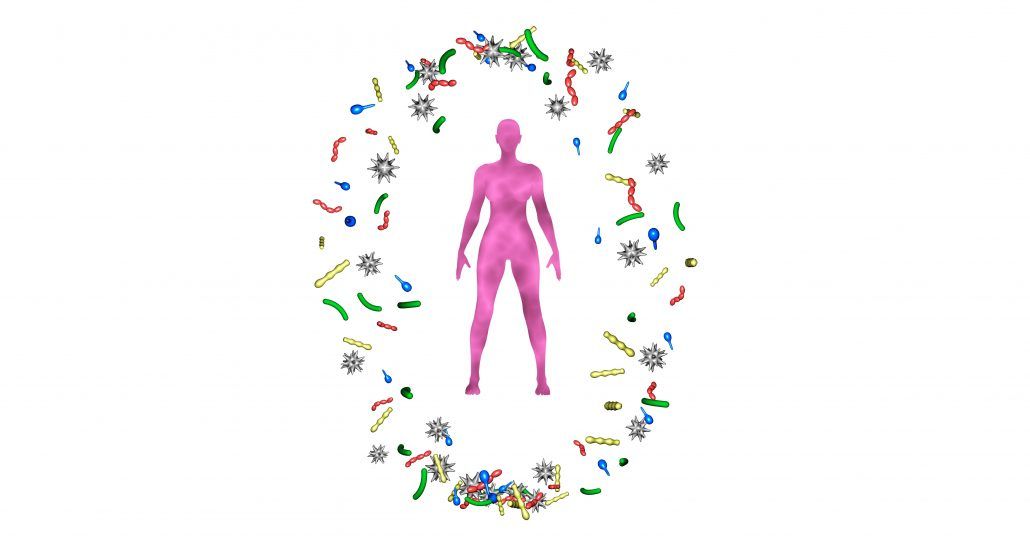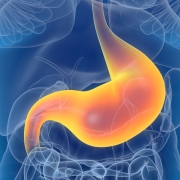Defining Microbiome: Meet Your Bacterial Buddies

You’re never alone. Your body is always crawling with trillions of microbial friends. That’s not a bad thing. All of them make up your microbiome—a word you hear a lot, but might not completely understand. Defining microbiome is actually pretty simple. It’s the collection of bacteria, fungi, protozoa, and viruses mentioned above. But don’t let the simple definition fool you. The microbiome is an expansive topic to discuss.
If this is your first time hearing about the microbiome, stay calm. There’s no reason to pull out the sanitizer. You shouldn’t feel gross or unclean. And your skin shouldn’t crawl because you’re an ecosystem for trillions of bacteria and microbes.
The microbiome is a normal part of a healthy life. Many studies suggest that your community of microbes could even play a large role in your health.
If you’re still a little uneasy, an introduction to your microbiome might help. So it’s time to go beyond defining microbiome and introduce you to your bacterial buddies.
A Bit of Basic Bacteria Biology
Other microbes live in your microbiome, but bacteria are the most studied, dominant portion. They’ll mostly be the focus of our attention moving forward. And basic information about bacteria is a great place to start the deeper discussion of the microbiome.
The first thing to know about bacteria—there’s a lot of them. Bacteria rule the earth, even though you can’t see them with your naked eye.
They make up the largest percentage of life on earth. Bacteria weigh more in total than all the humans on earth. One estimate puts the total number of bacteria at about five million trillion trillion. That’s a number so big it doesn’t even have a name. But it’s a five with 30 zeroes after it.
Second, bacteria are in the prokaryote domain. They’re single cells with a primitive outer membrane, no specific cellular parts, and no distinct nucleus. All the ingredients for life—DNA, proteins, and more—float around in the cytoplasm (a cellular liquid).
You fall under a different biological umbrella. Humans, animals, and other complex cellular life belong in the eukaryote domain. That’s because we’re multicellular organisms with membranes around our cellular organelles (cell parts with specific functions) and nuclei.
Your Body and Bacteria
Now that the basic biology is out of the way, it’s time to focus on the bacteria and microbes you interact with. Let’s start with the numbers.
While there’s more bacteria than about anything on earth, that’s not exactly the case with your body. Old estimates had microbiome cells outnumbering yours 10-to-1. Recent research suggest the ratio is closer to 1-to-1. That’s a tenth of what was once thought, but that means you’re still living with trillions of bacteria.
And there’s a great variety of bacteria and microbes inhabiting the communities created by your body. For example, your skin, nose, mouth, ears, and armpits all have very different inhabitants. There is even a difference in who is living between your toes versus other parts of the feet. Your gut—the place our mind goes first when say microbiome—can contain 40,000 different strains and species alone. This diversity is important, because it creates competition for space and food.
Like any lifeform, bacteria are selfish. They don’t live with you because they’re heroes and helpers. Bacteria’s biological imperative is to provide for themselves and their descendants. Luckily, your body has evolved to use the selfishness to its advantage. This creates a win-win situation (symbiosis). The bacteria get food and the body uses compounds produced by the bacteria.
These mostly productive relationships make it easy to think of bacteria as good or bad. That’s an oversimplification of the situation, though. There are some black-and-white cases—pathogenic bacteria that are out to harm you. But the majority of fall into a grey area because most are typically harmless or provide a slight benefit.
How you view specific bacteria (good or bad, healthy or harmful) has a lot to do with location. In one area of the body, a strain of bacteria can be beneficial—aiding in digestion or healthy immune function. In another area, that same type of microbe can cause problems. Sheer numbers can also present issues. For example, a weakened immune system can allow a strain of bacteria to multiply and grow to a population that’s problematic.
And the bacteria don’t suddenly decide to turn from heroes to villains. That’s not how they work. Bacteria act about the same all the time. They’re always selfish. And they’re always trying to multiply. But when they’re in the wrong place—where condition aren’t favorable for symbiosis—or they grow to large numbers, the microbes can wreak havoc.
But if bacteria are mostly harmless, and we shouldn’t call them good or bad, what’s the deal with probiotics? There are certain strains of bacteria that research has shown to provide benefits in certain situations. But in the context of your total bacteria—the trillions of cells and thousands of strains—those are rare, specific cases. That’s why it’s important to get probiotics that are tested and proven to survive in the right bodily environment and demonstrate benefits.
Finding Your Microbiome
Most people hear “microbiome” and think about the gut. Your lower digestive tract is packed with microbes. But it’s not the only place you can find different communities of diverse bacteria.
Let’s go through them:
- Gut: Your stomach doesn’t contain much bacteria. High acidity creates an uninviting environment where few can survive. Your intestines are a different story—mostly because that’s where food stays for the longest time. The gut microbiome has been extensively studied, so we can name many of the bacterial categories you’d find in your intestines.
- Both the small and large intestines are packed full of a variety of microbes, but Bacteriodetes (another category of bacteria) are very prevalent. And you’ll find distinct populations of bacteria in the small intestine and the large intestine, with different strains dominating each.
- Skin: Your body’s largest organ has its own community of bacteria and microbes. If you’re a germaphobe, this confirms your worst fears. You really are covered with bacteria. All the folds, nooks, and crannies of your skin provide ample space to develop diverse microbial communities. Remember, the vast majority are harmless in normal circumstances. And most of them can be categorized as Actinobacteria (a category of bacteria).
- Mouth: Your teeth, tongue, cheek, lips, and palate provide habitat for mostly harmless or beneficial bacteria. Almost 300 different species have been found in the mouth alone. And those are just the ones that have names so far.
- Ear, Nose, Sinuses, and Throat: Each of these regions contains bacteria that can thrive in that particular environment. But they’re mentioned together because they’re all connected. And they intersect with the mouth, as well.
This is not a comprehensive list of your body’s bacterial communities. They’re in your sex organs, lungs, and about any hospitable place they can find. The gut gets most of the attention, but researchers are looking more closely at other areas. That research will help us get to know our microbiomes better, and help us meet more of our bacterial buddies.
The Making of a Microbiome
You’re shaped by the ecosystem in which you live. Your microbiome is the same. But in this case, you’re the ecosystem.
That’s why everyone’s microbiome is unique. Yours is shaped by the experiences you have—starting at birth. Natural birth or Caesarean section will impact an infant’s microbiome. Your diet and environment impact your body and the bacterial friends that live with you. Age is also an important differentiating factor.
With the array of variables and huge variety of bacteria in your body’s ecosystem, it’s difficult to identify every strain of bacteria “normal” or “healthy” people will have. Mapping out your specific microbiome regularly over time is time consuming and overwhelming. And doing it once doesn’t tell you much. But talking more generally provides the information you need without listing thousands of bacterial strains.
Basically, the bacteria that coexist with you are the ones able to find a biological niche. They’re best able to adapt and survive in your specific conditions. In this way, you’re somewhat in control of your microbiome. And somewhat is the keyword. It’s not as easy as selecting your preferred bacteria, because you can’t control everything. We do know that good habits— sleeping well, exercising, and eating a healthy diet—encourage a beneficial microbiome.
But bacteria are living things. They’re competing with trillions of others for space and food. You can influence the results of this competition, but you can’t totally fix the game. And for those same reasons, your microbiome is constantly changing.
What Can the Microbiome Do for You?
The simple answer—your microbiome does a lot. And research is revealing more and more about what it does for you and your health.
This example tells you quite a bit: Mice raised without a community of bacteria—born and raised in a sterile environment—don’t exhibit the same type of growth as mice with a microbiome. Germ-free mice also show deficiencies in behavior and other health issues not seen in normal mice.
In general, your microbiome helps with digestive processes, immune function, maintaining a healthy weight, nervous system function, and more. But that’s another story. You can dive deeper into the ways your bacterial buddies help out your health in the next article in our microbiome series.











